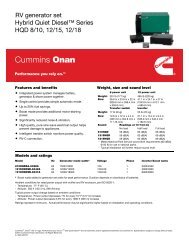Air Brake Manual
Air Brake Manual
Air Brake Manual
You also want an ePaper? Increase the reach of your titles
YUMPU automatically turns print PDFs into web optimized ePapers that Google loves.
· Make a chalk mark where the push rods enter the<br />
brake chambers.<br />
· Reapply spring parking brakes and measure the<br />
distance from the brake chamber to the chalk<br />
mark. Ensure the slack (push rod travel) is within<br />
1/2 - 3/4 inches or within manufacturer’s<br />
specifications and the angle between the slack<br />
adjuster and push rod is 90° or as close as<br />
practical. If not, then a brake adjustment is<br />
required.<br />
The following are recommended adjustment steps<br />
for S-cam brakes with manual slack adjusters.<br />
· Ensure vehicle is secure and wheels blocked,<br />
release the spring parking brake.<br />
· Verify reservoirs are at full pressure.<br />
· Use a wrench to disengage the external locking<br />
device (if so equipped) from the adjustment bolt of<br />
the slack adjuster.<br />
· Turn the adjustment bolt until the brake lining<br />
contacts the brake drum. If possible, visually<br />
check to see that the brake linings are in contact<br />
with the brake drum.<br />
· When turning the adjustment bolt on the slack<br />
adjuster, the S-cam should turn in the same<br />
direction as if a brake application were being<br />
made.<br />
· Back off the adjustment bolt about 1/4 to 1/2 of a<br />
turn. Check that the push rod free travel is now<br />
between 1/2 to 3/4 inches, or within<br />
manufacturer’s specifications.<br />
<strong>Brake</strong> Test<br />
· Reapply the spring parking brake, remove wheel<br />
blocks.<br />
· Gently tug against the spring parking brakes in<br />
low gear, it should hold the vehicle.<br />
· Release the spring parking brakes.<br />
· Move vehicle ahead slowly and make a service<br />
brake application to check brake response.<br />
Combination Unit<br />
When upgrading your driver’s licence from single to<br />
combination vehicles with air brakes, you will be<br />
required to satisfactorily demonstrate the pre-trip air<br />
brake inspection for combination vehicles.<br />
The pre-trip air brake inspection should be completed<br />
within 30 minutes. Failure to complete the test within<br />
30 minutes may result in the test being discontinued.<br />
Practical examination will be conducted in either the<br />
metric or imperial systems of measurement,<br />
whichever coincides with the equipment being<br />
operated.<br />
Vehicle Secure<br />
· Set the spring parking brake on tractor and trailer.<br />
· Block the wheels; the vehicle should be on level<br />
ground if possible.<br />
· Check that the compressor is secure.<br />
· Check the drive belt and pulleys for wear, cracking,<br />
slippage and tension (if equipped).<br />
· Drain all reservoirs completely on the tractor<br />
(wet/supply reservoirs first) then the trailer.<br />
When reservoirs are empty close the drain valves.<br />
“For testing purposes only, the applicant will not be<br />
required to manually drain the reservoirs. Instead,<br />
the applicant will verbally explain the steps that they<br />
would follow when draining the reservoirs and then<br />
fan the brake pedal to empty the reservoir.”<br />
· Check brake chambers, air lines and slack adjusters<br />
for security and wear.<br />
· Ensure the air brake glad hands and trailer electrical<br />
cord is connected properly.<br />
Compressor and Warning Devices Check<br />
· Start the engine and run at fast idle to build up air<br />
pressure.<br />
· Warning device(s) must operate to 55 psi or higher.<br />
· Ensure reservoir air pressure builds from 50 to 90 psi<br />
within three minutes.<br />
73




